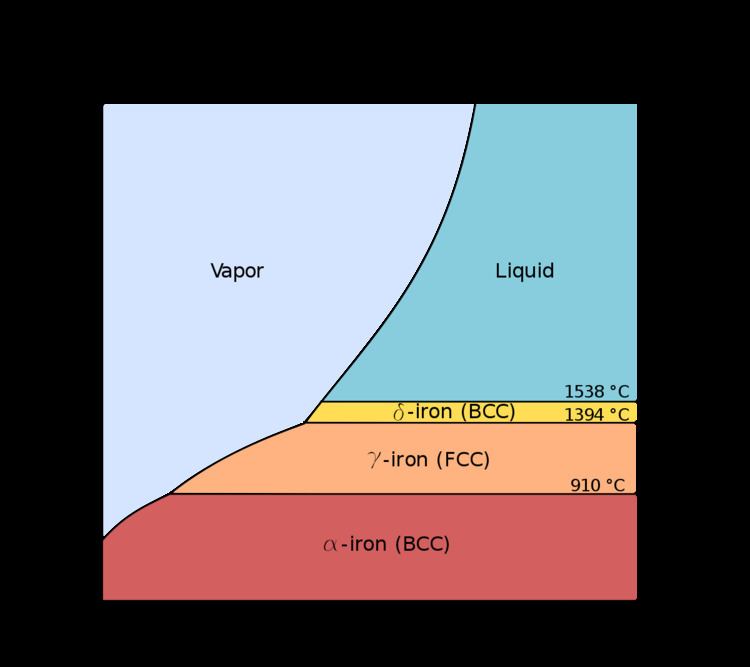 | ||
Iron represents perhaps the best-known example for allotropy in a metal. At atmospheric pressure, there are three allotropic forms of iron: alpha iron (α) a.k.a. ferrite, gamma iron (γ) a.k.a. austenite, and delta iron (δ). At very high pressure, a fourth form exists, called epsilon iron (ε) hexaferrum. Some controversial experimental evidence exists for another high-pressure form that is stable at very high pressures and temperatures.
Contents
- Delta iron Fe
- Gamma iron Austenite Fe
- Beta iron Fe
- Alpha iron Ferrite Fe
- Epsilon iron Hexaferrum Fe
- Experimental high temperature and pressure
- References
The phases of iron at atmospheric pressure are important because of the differences in solubility of carbon, forming different types of steel. The high-pressure phases of iron are important as models for the solid parts of planetary cores. The inner core of the Earth is generally assumed to consist essentially of a crystalline iron-nickel alloy with ε structure. The outer core surrounding the solid inner core is believed to be composed of liquid iron mixed with nickel and trace amounts of lighter elements.
Delta iron (δ-Fe)
As molten iron cools down, it solidifies at 1,538 °C (2,800 °F) into its δ allotrope, which has a body-centered cubic (BCC) crystal structure. δ-iron can dissolve as much as 0.09% of carbon by mass at 1,493 °C.
Gamma iron / Austenite(γ-Fe)
As the iron cools further to 1,394 °C its crystal structure changes to a face centered cubic (FCC) crystalline structure. In this form it is called gamma iron (γ-Fe) or Austenite. γ-iron can dissolve considerably more carbon (as much as 2.04% by mass at 1,146 °C). This γ form of carbon saturation is exhibited in stainless steel.
Beta iron (β-Fe)
Beta ferrite (β-Fe) and beta iron (β-iron) are obsolete terms for the paramagnetic form of ferrite (α-Fe). The primary phase of low-carbon or mild steel and most cast irons at room temperature is ferromagnetic ferrite (α-Fe). As iron or ferritic steel is heated above the critical temperature A2 or Curie temperature of 771 °C (1044K or 1420 °F), the random thermal agitation of the atoms exceeds the oriented magnetic moment of the unpaired electron spins in the 3d shell. The A2 forms the low-temperature boundary of the beta iron field in the phase diagram in Figure 1. Beta ferrite is crystallographically identical to alpha ferrite, except for magnetic domains and the expanded body-centered cubic lattice parameter as a function of temperature, and is therefore of only minor importance in steel heat treating. For this reason, the beta "phase" is not usually considered a distinct phase but merely the high-temperature end of the alpha phase field.
Alpha iron / Ferrite (α-Fe)
At 912 °C (1,674 °F) the crystal structure again becomes BCC as α-iron is formed. The substance assumes a paramagnetic property. α-iron can dissolve only a small concentration of carbon (no more than 0.021% by mass at 910 °C).
At 770 °C (1,418 °F), the Curie point (TC), the iron is a fairly soft metal and becomes ferromagnetic. As the iron passes through the Curie temperature there is no change in crystalline structure, but there is a change in the magnetic properties as the magnetic domains become aligned. This is the stable form of iron at room temperature.
Epsilon iron / Hexaferrum (ε-Fe)
At pressures above approximately 10 GPa and temperatures of a few hundred kelvin or less, α-iron changes into a hexagonal close-packed (hcp) structure, which is also known as ε-iron or hexaferrum; the higher-temperature γ-phase also changes into ε-iron, but does so at a higher pressure. Antiferromagnetism in alloys of epsilon-Fe with Mn, Os and Ru has been observed.
Experimental high temperature and pressure
An alternate stable form, if it exists, may appear at pressures of at least 50 GPa and temperatures of at least 1,500 K; it has been thought to have an orthorhombic or a double hcp structure. as of December 2011, recent and ongoing experiments are being conducted on high-pressure and Superdense carbon allotropes.
